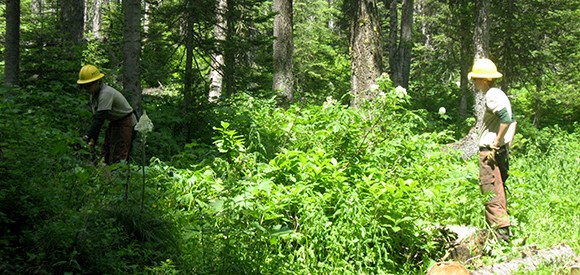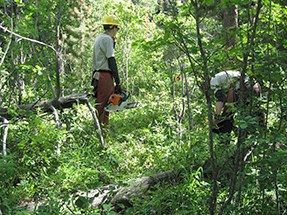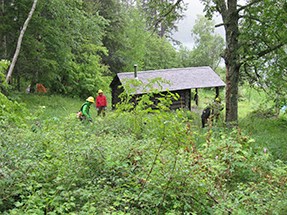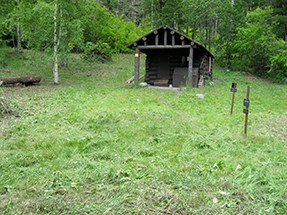Last updated: January 17, 2017
Article
Wildland Fire: Montana Conservation Corps Completes Fuels Projects

A Montana Conservation Corps crew, funded by the Glacier National Park Conservancy, dedicated 10 days to working on fuels projects at Glacier National Park in 2013.
“We accomplished 10 acres of wildland-urban interface mitigation work at very little cost to the park.”
—Brad Harris, Glacier National Park fuels specialist

Looking for creative ways to fund hazardous fuels reduction projects, Glacier fuels specialist Brad Harris enthusiastically read an email from the park’s volunteer coordinator that said a Montana Conservation Corps crew from Kalispell was available if there was any work for them. To make the offer even more enticing, the Glacier National Park Conservancy would fund the crew.
Harris contacted the crew, which normally does trails work for federal agencies, to see if they would be interested in a project for defensible space maintenance surrounding remote and front-country park structures. As it turned out, the crew dedicated 10 days to working on fuels projects at Glacier National Park in late June through early July 2013.

“We started with two remote cabins that I knew our engine crews would have a hard time getting to during fire season,” said Harris, who went along with the group for the 10 days. For the first project, Harris and the five-person crew hiked in 6.5 miles into the Kintla Lake backcountry cabin. One crew member was a B faller, enabling her to fell some smaller trees and buck larger material. The primary focus was the removal of ladder fuels and the cutting and piling of grass, brush, and dead and downed material surrounding the cabins.
The second project was a culturally significant site in the North Fork region of the park. The crew spent one day clearing and piling debris surrounding an outhouse, barn, and root cellar within an old homestead.
“Most people didn’t even realize the root cellar was there due to overgrowth surrounding it,” Harris said. “I wanted them to see as much of the park as possible while they were here, and to appreciate the different types of park values we try to protect from wildfire.”
For the third project, the crew went to Many Glacier to work on defensible space for three structures around the Sherburne Entrance Station. The crew handled the majority of the work with saws and brushcutters, then the Glacier fire crew followed up by taking care of the larger, complex hazard trees that needed felling.

The next project required a 13.5-mile hike into the Upper Park Creek cabin. Early summer is a very busy time for the park packers, so the crew hauled all their equipment – chain saws, brushcutters, pole saws, fuel, and personal gear. They also packed a spotting scope to survey for mountain goats in Park Creek, part of a “citizen science” project for the Crown of the Continent Research Learning Center.
“It was a good niche for the MCC crew to work around the cabins that our crew wouldn’t get to,” Harris said. “They focused on some of the more tedious work of hand piling all the old scattered dead and downed fuel and cutting brush within 75 feet of the structures.”
On the last afternoon of their tour, the crew worked around the Walton Ranger Station, building a few more piles after hiking out from the Upper Park Creek cabin. “They were a great crew--I was really impressed with the crew’s safety and work ethic, physical fitness and attitude,” Harris said. “We accomplished 10 acres of wildland-urban interface mitigation work at very little cost to the park. This opened the door for future fuels work with the MCC crews.”
Contact: Dave Soleim, Glacier National Park fire management officer
E-mail: e-mail us
Phone: (406) 888-5803
